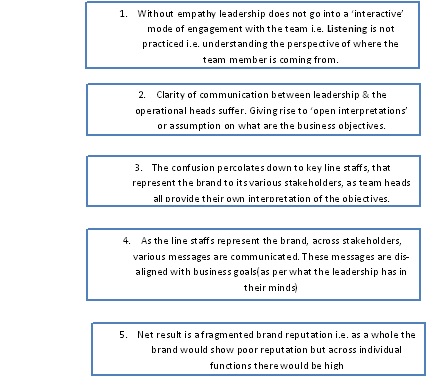
Empathy or showing the understanding side of our human selves is often confused as a ‘weakness’ by many a leader.
Lack of empathy comes about from a pre-determined effort to keep emotions out of work related issues.
Yet we forget that at the core of our being, emotions are an extremely strong driver for all our actions.
A lot of literature is available on this. The purpose of my post is not to belabor this point but to highlight how lack of empathy in the leadership style of an organisation directly impacts on a brand’s’ reputation.
Most organisations operate on the classical 6-styles of leadership (Visionary, Coaching, Affiliative, Democratic, Pacesetting, Directive). They often tend to miss out on the all important aspect of empathy.
These styles, whilst good in their own way, come from a management school of thought where achievement (at any cost) was the primary objective. Today much work has been done in aligning these leadership styles with both, technical competencies and behavioural attitudes, or in other words marrying logic with emotion.
Organisations have realised that employees are creatures of habit. Habits that were formed much earlier in their lives before they became employees.
Changing habit is a huge task and oft fraught in failure.
By using the right leadership styles combined with key behavioural attitudes and technical competencies, behavioral changes impacting on work flow processes can be influenced. Over time the methodology of an activity workflow results in the employee behaving in a planned way so as to provide the desired customer experience.
The way I have written it may seem to make the task, of having the right leadership style laced with the right behavioural attitudes, simple.
Whilst it is simple, the devil lies in the detail and the extent of granularity that an organisation would want to go to.
The flow chart depicts the reality that takes places:

With a fragmented reputation the stakeholders interacting with the brand would be cautious of increasing their interactions. This results in a few ‘lows’:
- Externally there would be lower referrals & lower sales
- Internally there would be low employee engagement, low productivity, creativity and low revenue.
End of the day resulting in shrinking profits and market presence up until the point where sustainability of the entire organisation is at stake.
A sure way to avoid this in today human-to-human interface in all facets of life, not just business, is to be able to empathise with your audience and your team and build engagement from that to be sustainable.
(This post was published in Linked In on Aug 14,2014.)